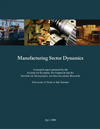Read the Study: Manufacturing Sector Dynamics
Over the past 50 years, the proportion of Americans employed in manufacturing jobs has declined steadily. Today, less then one in ten U.S. workers are employed in the manufacturing industry. Industry churn has implications for both communities and individuals that rely on the economic value of manufacturing plants and jobs. Following three years of study, Manufacturing Sector Dynamics outlines the trends and requirements of manufacturing in the United States, and presents policy recommendations for how the U.S. Economic Development Administration and others can help stem and adjust to the impact of declines in U.S. manufacturing.
Based on both primary research and review of the literature, Manufacturing Sector Dynamics outlines eight policy recommendations built from study findings:
I. Focus on human capital development and company competitiveness, and in the long term communities can recover from major employment losses.
II. Community leaders can rarely prevent but can usually prepare for manufacturing sector losses. By preparing community conditions for manufacturing success, they can take advantage of new opportunities.
III. Regional development and industry cluster strategies can offer the best options to sustain better manufacturing jobs, along with a focus on the regional infrastructure connecting labor and material to plant sites.
IV. The most important success factor for manufacturing is a high-performance workforce.
V. Higher education institutions are viewed as a critical resource for multiple economic development roles, in both job loss and gain scenarios.
VI. Incumbent manufacturing firms can offer the best prospects for long term job creation and competitiveness.
VII. Entrepreneurship balances a healthy economic development portfolio to harness the advantages of both early stage enterprises and larger manufacturing firms, and in some cases offers the only available option to grow.
VIII. Regional manufacturers and economic developers cannot remain on the sidelines of internationally competitive markets.
Powerpoint presentation at the 2008 Regional Economic Development Conference of the U.S. Economic Development Administration, New Orleans.
The research was conducted by the Institute for Economic Development and the Institute for Demographic and Socioeconomic Research at the University of Texas at San Antonio. The project was conducted under an award from the Economic Development Administration, U.S. Department of Commerce.
Manufacturing Sector Dynamics draws on two technical research reports that provide more detail on approach and findings:
T1: Human Capital in Manufacturing: Comparisons among the U.S., Texas, Arkansas, and Three Texan Communities. (PDF, 175pp.)
T2: Socioeconomic Impacts of Manufacturing in Selected Arkansas and Texas Communities. (PDF, 103pp.)
____________________________ END __________________________________




